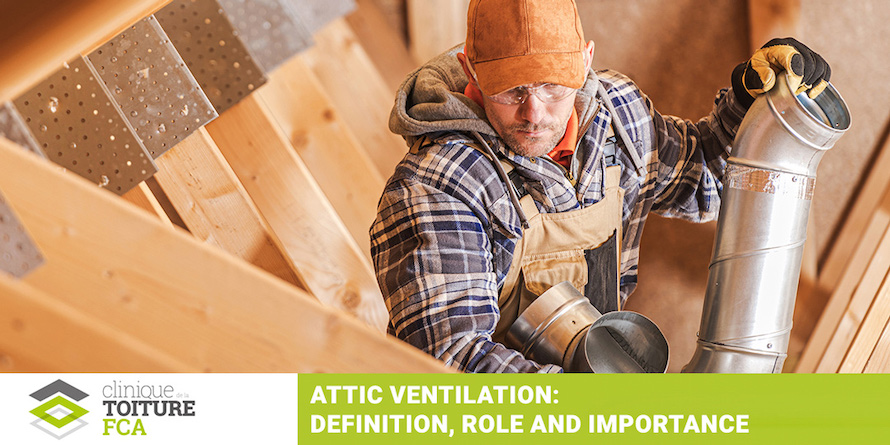
Home > Blog posts > Attic Ventilation: Definition, Role and Importance
Attic Ventilation: Definition, Role and Importance
When thinking about the structure of a roof, the attic is often forgotten. However, this empty space between the roof and the house plays an important role in regulating temperature and humidity.
Clinique de la toiture FCA shares with you some tips to ensure proper ventilation of your home’s attic.
What is attic ventilation?
Ventilation is all about air circulation: there are air outlets (provided by the vents) and air inlets (provided by the soffits). Both are essential to ensure proper attic ventilation.
Be sure to keep an eye out for unwanted openings that negatively impact ventilation. These must be sealed.
Roles and importance of attic ventilation
By preventing condensation, which can lead to mould and rot, proper ventilation of the attic will prolong the life of your roof and avoid costly renovations.
- Removing moisture
Moisture will quickly damage any roof: in fact, your roof is at risk of developing mould and rot, which damage it quickly. Removing moisture is therefore essential to keeping your roof in good condition.
- Heat loss
Since heat always moves upwards, heat from your home will tend to accumulate in your attic. This heat brings with it moisture that must also be removed for the reasons stated above.
- Avoiding the formation of heat islands
Heat islands caused by insufficient ventilation will cause your roof covering to overheat. In the winter, this will cause snow to melt, and this hot-cold contact will promote the formation of ice on the roof.
Ratio of insulation to attic ventilation
Ventilation allows the heat to be released from the attic, while insulation will limit heat loss through the attic, among other benefits. This combination protects the roof by limiting the humidity that is found there, while also limiting the entry of cold air into the house. That means that the temperature inside the home will be more comfortable. Moreover, by ensuring proper insulation and ventilation, you will save a lot of money on your electricity bill.
How to properly ventilate the attic?
Attic ventilation uses soffits (air intakes) and vents (air outlets). If you are using insulation, you should leave some space to make sure that ventilation is not impeded and that the soffits are not obstructed.
- Number of vents
The number of vents required will depend on the surface area and the slope of the roof. It is calculated based on set ratios. If the slope is greater than 1/6, for a ceiling covered with insulation, the required ventilation area is 1/300 of the total surface. If the slope is less than 1/6, the ratio will be 1/150 of the surface.
- Arrangement of the vents
Soffits should be perforated along the underside of the roof’s overhang, also known as the eaves of the roof. Vents should be placed evenly across the top of the roof to ensure adequate ventilation of the attic.
- Distribution of the vents
In order to provide effective ventilation of the entire attic, the vents must be evenly distributed on opposite sides of the building. The distribution should be at least 25% on the top and 25% on the bottom.
Roof ventilation standards
The Quebec Construction Code established several standards that must be met for ventilation (in Section 9.19. Roof Spaces, 2005). Among other requirements, it sets the standard in terms of the quantity and location of vents; these requirements depend on the slope of the roof.
Ventilation of a flat roof
Flat roofs have different requirements for both insulation and ventilation. In particular, the installation of a vapour barrier will prevent warm and humid air from migrating into the attic.
In fact, many older buildings with flat roofs do not use any ventilation systems for the attic at all; this usually doesn’t cause any problems until renovations are made to replace the walls, doors and windows to make them more airtight. With nowhere to escape, warm air will accumulate in the attic and will cause condensation.
Square ventilators are designed specifically for flat roofs and will ventilate the attic adequately, provided they are installed in sufficient numbers according to the surface area of your roof.
If you are looking to renovate your roof to improve its ventilation and insulation, a government grant could help you out! These renovations can also make your home more energy efficient, so it’s a win for everyone involved. Don’t hesitate to contact Clinique de toiture FCA for advice on roof renovations and repairs.
Need help?
Leave us your email address and we will contact you as soon as possible to assess your needs!
Put an end to your water infiltration your clogged drains your roof problems
Leave us your email address and we will contact you as soon as possible to assess your needs!
